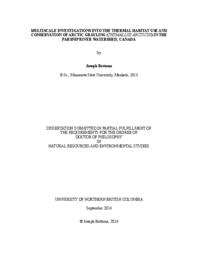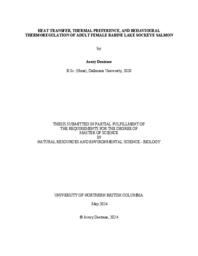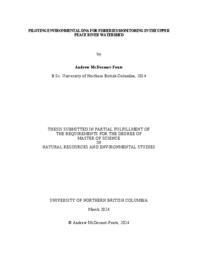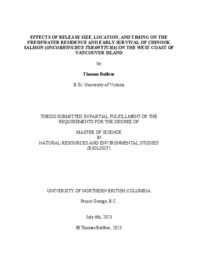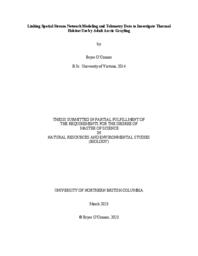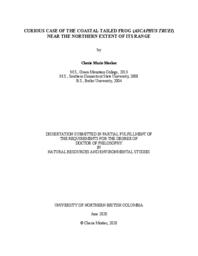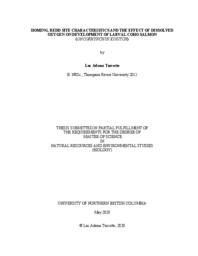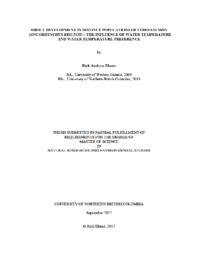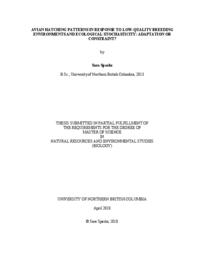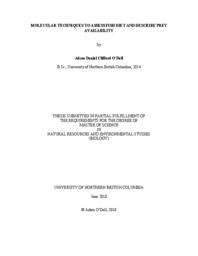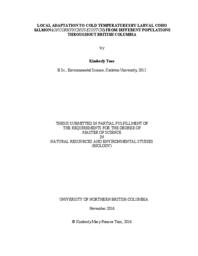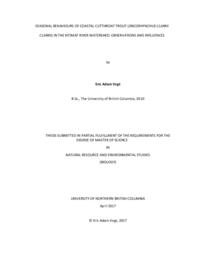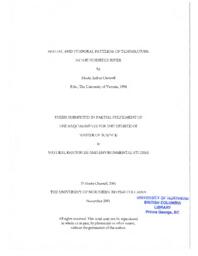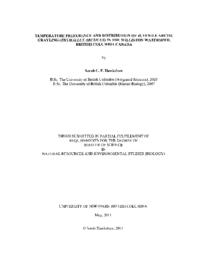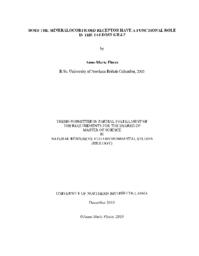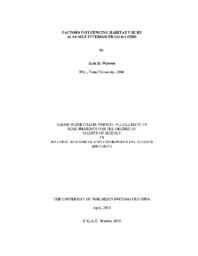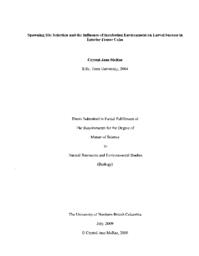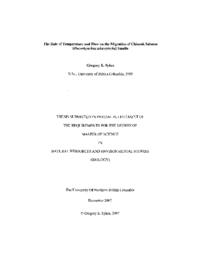Shrimpton, Mark
Person Preferred Name
Mark Shrimpton
Related Works
Content type
Digital Document
Origin Information
Content type
Digital Document
Origin Information
Content type
Digital Document
Origin Information
Content type
Digital Document
Origin Information
Content type
Digital Document
Description / Synopsis
Applications of environmental DNA (eDNA) represent one of the most significant recent advances in aquatic species monitoring. eDNA has the potential to dramatically increase the effectiveness and efficiency of fisheries monitoring across large geographic areas and particularly for species that have traditionally been difficult to survey. The Williston Reservoir and its surrounding watershed in northern British Columbia is a vast and heavily disturbed aquatic ecosystem where fish stocks have been difficult to monitor with traditional survey techniques. Although eDNA has many potential benefits, the validation process required in a novel environment can be a barrier to adoption. Primer choice and validation, study design and laboratory workflows are critical considerations for eDNA studies and must be evaluated when developing a novel approach in a particular geographic area. My research advanced the validation of species-specific eDNA assays for six prominent pelagic species in the Williston Reservoir and a generic, metabarcoding primer set that was effective in detecting the diversity of fish in the surrounding streams and rivers. The species-specific approach included the validation of four published assays and the development of novel assays for detecting lake trout (Salvelinus namaycush) and peamouth (Mylocheilus caurinus). Lake trout and bull trout (Salvelinus confluentus) are very closely related species that are sympatric throughout much of northwestern North America. The development of a novel lake trout assay that did not cross amplify bull trout eDNA is an important achievement for species-specific eDNA monitoring. Reservoir samples were collected from above and below the thermocline during the summer when the reservoir was stratified to identify species-specific patterns of eDNA distribution throughout the water column. Species detections in the reservoir were comparable for species-specific and metabarcoding assays when compared against gillnet catches in the reservoir. Abundant species that exhibit diel vertical migrations were detected by eDNA and gillnets at all depths. eDNA copy numbers detected were higher for samples with greater abundance and biomass of each species caught in the gillnets. Samples collected from tributaries around the reservoir were tested with metabarcoding primers and species detections were compared to results from a species-specific assay for Arctic grayling and a snorkel survey. Metabarcoding results were comparable to those from the Arctic grayling eDNA study and the snorkels survey, although the metabarcoding methods in this study were less sensitive due to a reduced amount of sample replication. Piloting eDNA in the Williston Reservoir and surrounding watershed has provided valuable insights into eDNA sampling design and the overall workflow for future eDNA studies in the region.
Origin Information
Content type
Digital Document
Description / Synopsis
Hatchery enhancement of declining Pacific salmon populations has long been a foundation of salmon management; however, the influence of hatchery release practices on freshwater residence time and survival to estuarine entry is not well-understood. This study employed Passive Integrated Transponder (PIT) tags to evaluate the relationships between the size of individuals at release, release location, and release timing on the duration of freshwater residence and survival of hatchery-produced Chinook salmon (Oncorhynchus tshawytscha) in the 103 km2 Toquaht River watershed, located on the west coast of Vancouver Island, British Columbia. The Toquaht River mainstem is ~22 km in length, divided into upper and lower sections by the 118 ha Toquaht Lake. A total of 4848 PIT-tagged Chinook salmon smolts were released on three dates (May 23rd, June 9th, June 19th), and during each release, fish were split evenly between three different locations within the watershed (Toquaht Lake: 7.9 km from the detection array; upper river: 11.9 km from the array; and the lower river: 4.1 km from the array). The detection data were analyzed using an integrated model of freshwater residence and capture–recapture fitted using Bayesian inference. The duration of freshwater residence between release and detection ranged from 0.5–60 days, with a mean of 14 days, and exhibited a negative relationship with fish size. The estimated median survival probability for all locations and dates was 0.39, with the highest probability of survival (0.78) found in fish released into the lake on June 19th and the lowest (0.06) for lower-river fish released on June 9th. Changes in streamflow were likely responsible for the observed pattern in survival by date. Survival probability decreased as fish size increased. Overall, the study provides further evidence that hatchery release strategies can significantly influence freshwater residence and survival, and these practices should be well-understood and flexible in the face of changing environmental conditions. The results of this study may have significant implications for the management of Toquaht River Chinook salmon, particularly in the context of ongoing efforts to rebuild the naturally spawning population.
Origin Information
Content type
Digital Document
Description / Synopsis
River networks have a high amount of thermal habitat heterogeneity which is a critical abiotic factor driving freshwater fish distribution. The fitness repercussions of residing outside a species’ optimal thermal limits, and the resulting behavioural responses to stress, restrict the amount of freshwater habitat available to ectothermic organisms. Changes in ectotherm distribution due to climate-related shifts in thermal habitat availability have been well documented and have been especially pronounced at distributional limits. My objective was to characterize variations in the availability of thermal habitat and quantify its influence on the distribution of a cold-water adapted aquatic ectotherm, Arctic grayling in the Parsnip River watershed in northern British Columbia. The presence of a thermal gradient in the watershed was revealed by a spatial stream network model and its influence on adult Arctic grayling summer distributions was explored with a dynamic site occupancy model using acoustic telemetry data. Results suggest a high probability of occupancy (> 0.75) at temperatures ranging from 8.7-14.2ºC with a peak at 10.9ºC. The distribution of thermal habitat within this range was limiting in only one of the three years during the study period. In 2021 the distribution of thermal habitat with a high probability of use during the study period was reduced to 57% of the accessible watershed length from 89% in 2019 and 87% in 2020. Small streams in high elevation tributaries (e.g., >800 m) are important cold-water sources for Arctic grayling refugia under warm conditions. Increased habitat protections for high elevation streams should be prioritized to ensure a future for cold-water adapted species in the Parsnip River watershed.
Origin Information
Content type
Digital Document
Description / Synopsis
Predation of fish raised and released as part of conservation aquaculture programs can pose a threat to the recovery of endangered populations. Therefore, understanding the impact of specific predators is important to inform these programs. In central British Columbia, a conservation aquaculture program exists for the endangered Nechako white sturgeon (Acipenser transmontanus). In Chapter 1, I provide evidence that river otters (Lontra canadensis) are a notable predator of these released sturgeon through the collection of over 500 sturgeon PIT tags from river otter latrine sites and finding sturgeon radio tags in suspected otter feeding sites. In Chapter 2, I used the collection of additional PIT tags to estimate the extent of predation and to identify spatial and temporal patterns in the predation. My results suggest a confirmed minimum of 3.9% of released sturgeon were consumed by otters, however, I also identify several factors that suggest this number is much higher. Predation hotspots were identified and varied depending on release year and location, and predation evidently decreased with a shift to low release numbers and fewer sturgeon being present in the river. In Chapter 3, I present the results of laboratory experiments I performed that revealed an inability of naïve juvenile white sturgeon to be conditioned to recognize otters as a threat using conspecific alarm cues. However, spatial avoidance was identified as an important anti-predator response and suggestions are provided to improve future experiments. My findings specifically inform the recovery of the Nechako white sturgeon, however, may also be informative where other populations of sturgeon and otters coexist. Additionally, as this predator-prey interaction was previously unstudied, my results contribute to a growing knowledge of sturgeon predators.
Origin Information
Content type
Digital Document
Description / Synopsis
Kokanee, the non-anadromous life history form of Oncorhynchus nerka, use lacustrine habitat in watersheds draining into the north Pacific Ocean. Kokanee have also been widely introduced into reservoirs following impoundment of rivers due to the construction of dams. Locally-adapted subpopulations of Kokanee, however, should be identified and evaluated when implementing watershed-level management strategies. In Chapter 1, I examined fork length, condition factor, and age at maturity for Kokanee in the Williston watershed of northern British Columbia to identify potential spatial and temporal trends in demographic structure following a large-scale stocking program that occurred in the 1990s. Adult spawning Kokanee that were native to the reservoir and collected prior to stocking events were significantly larger and maintained higher condition factors than Kokanee stocked from the Columbia River sampled in any year after 1991. Introduced Kokanee sampled in 2018 and 2019 were the smallest spawners and were significantly smaller than all fish collected between 1989 and 2018; the condition factors of these fish were also significantly lower than native Kokanee and the first spawning cohorts of Columbia-origin fish. The average age at maturity did not change across spatial or temporal scales (3 yrs.). My results indicate an ongoing trend of decreasing spawner size and condition factor for Kokanee in the Williston Reservoir since introduction events in the early 1990s. In Chapter 2, I analyzed the genetic population structure of Kokanee in the Williston watershed, including from the reservoir before stocking Columbia-origin fish and native populations from headwaters of the Williston Reservoir: Thutade, Arctic, and Tacheeda Lakes. Using microsatellite markers, I identified that all fish collected from 2006 to 2019 were introduced Columbia-origin genotypes, and there was no evidence of genetic divergence by spawning location. Native populations in Arctic and Tacheeda Lakes remained entirely separate from the reservoir populations, and there was no indication of past or current introgression with introduced stock. I identified that native Williston Reservoir Kokanee diverged from the Thutade Lake population; as native Williston fish have not been sampled since 2000, it is likely that this population has been extirpated in the reservoir by the successful Columbia-origin lineage. My results highlight an unfortunate consequence of underinformed management practices that failed to recognize the native Williston Kokanee as a distinct population. Strategies that incorporate knowledge of subpopulations of Williston watershed Kokanee, such as genetic populations or reproductive ecotypes, should be prioritized to conserve locally-adapted genetic diversity.
Origin Information
Content type
Digital Document
Description / Synopsis
Ascaphus truei, an ancient species of frog, migrated into British Columbia, Canada, following the last ice age. A. truei is of conservation interest because forestry practices, and the associated infrastructure, may reduce habitat quality. There is also concern that a warmer and drier climate will change the distribution and abundance of this species. I used two genetic methods, microsatellites and next-generation sequencing, to compare the genetic diversity of A. truei from the northern extent of its range in British Columbia, CA to southern Washington, USA. Both methods suggested a dramatic reduction in diversity across the northern portion of the species’ range. The phylogeography suggests a northern range expansion from a single refugium. I used DNA metabarcoding to compare the gut contents of larvae across three stream reaches and two development classes near the northern extent of A. truei's range. Gut contents differed between stream reach but did not differ among development class. Wetted width and ultimately stream volume may influence differences in gut content among stream reaches. I also quantified the relationship between an index of larvae density and environmental factors hypothesized to influence population density near the northern extent of the range. I assessed the segregation of larvae at various developmental stages. Wetted width and wetted depth correlated with differences in the abundance of larvae. Older developmental stages were captured in stream reaches with greater slopes than younger stages. Management should minimize modifications of stream structure, such as in-stream siltation due to road building. We should maintain habitat connectivity and gene flow to ensure the continued migration and adaptive capacity of A. truei.
Origin Information
Content type
Digital Document
Description / Synopsis
Life histories of Pacific salmon are remarkable in that they return to specific freshwater sites to spawn after multiple years of ocean residence. In Chapter 1, I investigated site fidelity at a reach scale for Interior Fraser Coho Salmon (Oncorhynchus kisutch) (IFC). Coho Salmon eggs were incubated at known spawning locations in the Coldwater River, British Columbia, to obtain reference data for comparison to otolith signatures of returning adult salmon. The majority of adults (67%) returned to their natal spawning locations at the reach scale, while 33% strayed to other spawning sites within the Coldwater River, illustrating straying at small scales. Straying to novel incubation sites at the reach scale demonstrated plasticity in homing within a watershed. In Chapter 2, I investigated the characteristics of the hyporheic redd zone over two years where Coho Salmon were observed to spawn. Within a reach, physical variables were homogenous, but heterogeneity was found among reaches where Coho Salmon were observed to spawn – particularly for intragravel temperature and dissolved oxygen. The difference in temperature and dissolved oxygen among sites had a pronounced effect on survival, rate of development, and emergence time for Coho Salmon fry. Heterogeneity among spawning locations demonstrate trade-offs that exist between rate of development and survival. Chapter 3 investigated the effect of low and variable dissolved oxygen on developing salmon embryos. A family effect was found as smaller eggs produced smaller alevin, but the effect of low dissolved oxygen on growth was also greater for the families with small eggs. Treatment affected rate of development and initially had an effect on length and mass, but by button-up there was no longer an effect of low dissolved oxygen on size. My work demonstrates plasticity in Coho Salmon at different life stages. Plasticity is important for utilizing new habitats or adapting to existing habitats as they change.
Origin Information
Content type
Digital Document
Origin Information
Content type
Digital Document
Origin Information
Content type
Digital Document
Origin Information
Content type
Digital Document
Origin Information
Content type
Digital Document
Origin Information
Content type
Digital Document
Origin Information
Content type
Digital Document
Origin Information
Content type
Digital Document
Origin Information
Content type
Digital Document
Origin Information
Content type
Digital Document
Origin Information
Content type
Digital Document
Origin Information
Content type
Digital Document
Origin Information
Content type
Digital Document
Origin Information
Content type
Digital Document
Origin Information



